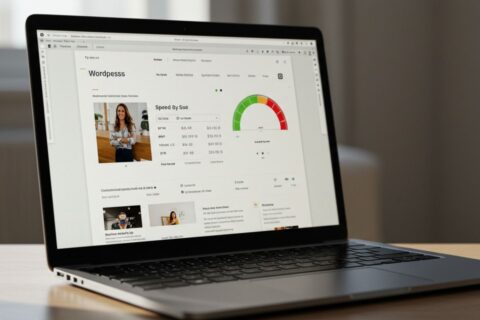Your real estate website isn’t just an online brochure, it’s your digital storefront, lead generator, and trust-builder all in one. In an era where over 90% of homebuyers start their search online, your website plays a vital role in shaping first impressions and driving client decisions. Whether you’re a solo agent, part of a growing team, or leading a large brokerage, your website should do more than just display listings—it should guide, engage, and convert visitors into leads.
In this blog, we’ll break down the top 10 real estate website design mistakes you need to avoid in 2025. From mobile responsiveness to SEO and user experience, we’ll explore where most real estate websites fall short—and how you can fix these issues to create a high-performing site that stands out in a crowded market.
Why Real Estate Website Design Matters in 2025?
Home buyers and sellers are online more than ever. In fact, 97% of homebuyers use the internet during their home search (NAR, 2023). If your website is hard to navigate, slow, or looks outdated, you’re likely losing clients before they even contact you. Great design isn’t just about looks—it’s about creating a smooth and helpful experience. That’s where user experience in real estate websites becomes crucial. A professionally designed real estate site builds trust, improves SEO rankings, and increases your conversion rate. Think of your website as your 24/7 digital salesperson.
Leading Website Deevelopment Agency in Canada
Top 10 Real Estate Website Design Mistakes to Avoid
1. Poor Mobile Responsiveness:
Over 58% of website traffic now comes from mobile devices (Statista, 2024). If your site doesn’t adjust well to phones or tablets, users will bounce. This is one of the most common real estate website problems. Make sure your images scale properly, text is readable, and buttons are easy to tap.
2. Cluttered or Outdated Homepage:
Too much text, mismatched fonts, and irrelevant information make your site look untrustworthy. Clean, modern layouts with strong visuals are key. One of the top 10 real estate website design mistakes is trying to say everything at once. Focus on what matters most to your visitors.
3. No Clear Call-to-Action (CTA):
Do visitors know what you want them to do next? Whether it’s “Schedule a Viewing” or “Get a Free Home Valuation,” make your CTAs stand out. Many websites fail here, resulting in missed leads.
4. Incomplete or Low-Quality Property Listings:
This is a deal-breaker. Missing photos, outdated pricing, or vague descriptions will push buyers away. High-quality listings with 8–12 images, detailed info, and a map view increase engagement significantly.
5. Slow Page Speed:
Google states that 53% of mobile users leave a page if it takes more than 3 seconds to load. If your site is slow, you’re not just losing traffic—you’re damaging SEO. Compress images, use a reliable hosting provider, and reduce plugin bloat. These are key tips to fix a slow real estate website.
6. Not Using Local SEO Best Practices:
If you want to show up when someone searches “homes for sale in [City],” your site must be optimized for local SEO. That means adding city pages, Google Business Profile links, schema markup, and locally focused keywords.
7. Complicated Navigation or Site Structure:
Visitors should be able to find what they need within 2–3 clicks. If your menus are confusing or your listings are buried, that’s a problem. One of the mistakes to avoid in building a property listing site is ignoring intuitive navigation.
8. No Lead Capture Mechanisms:
Are you collecting visitor emails? Offering downloadable guides, free home evaluations, or newsletter signups are great ways to build your lead list. Without this, you’re letting hot leads walk away.
9. Lack of Social Proof or Testimonials
Trust is key in real estate. Add client reviews, success stories, and Google ratings. Social proof increases conversion rates and helps turn cold visitors into warm leads.
10. Generic Stock Photos or Poor Visuals:
Buyers want to see real homes and real agents. Avoid overused stock images. Instead, use high-resolution images of your actual listings, neighborhoods, and team. This adds authenticity and improves user experience in real estate websites.
Website Design for Real Estate Company: Key Features That Convert Visitors into Clients
How to Fix These Mistakes and Build a High-Converting Real Estate Website?
- Focus on mobile-first, responsive design
- Optimize load speed: use caching and compress images
- Improve your CTAs: use action words and eye-catching buttons
- Structure your site clearly: use filters, search, and simple menus
- Invest in high-quality listing pages and updated content
- Implement local SEO and use schema markup
- Add testimonial sliders and real-time social proof widgets
- Set up lead capture forms, chatbots, or pop-ups
These are proven real estate website design tips that can help you turn traffic into leads.
Also Read: Best Web Development Frameworks for 2025
Final Thoughts:
Your website is your biggest online asset. Avoiding these top 10 real estate website design mistakes can make all the difference in how users interact with your brand. If you’re serious about standing out in the crowded real estate market, start with fixing these real estate website design mistakes and focus on creating an experience that users trust, understand, and want to come back to. Remember, avoiding these mistakes to avoid in building a property listing site isn’t just about design—it’s about building relationships. Use these real estate website design tips to create a high-performing site that brings real results.
FAQs
Q1: How often should I update my real estate website design?
A: Ideally every 2-3 years or whenever major UX trends or platform upgrades change.
Q2: Should I use a template or custom design for my real estate website?
A: Templates are cost-effective but custom designs offer flexibility and brand uniqueness.
Q3: What’s the most important feature on a real estate website?
A: A responsive, easy-to-use property search function combined with high-quality visuals.
Q4: How can I improve my real estate website’s SEO?
A: Use local keywords, create city-specific landing pages, optimize images, and ensure fast load times.







